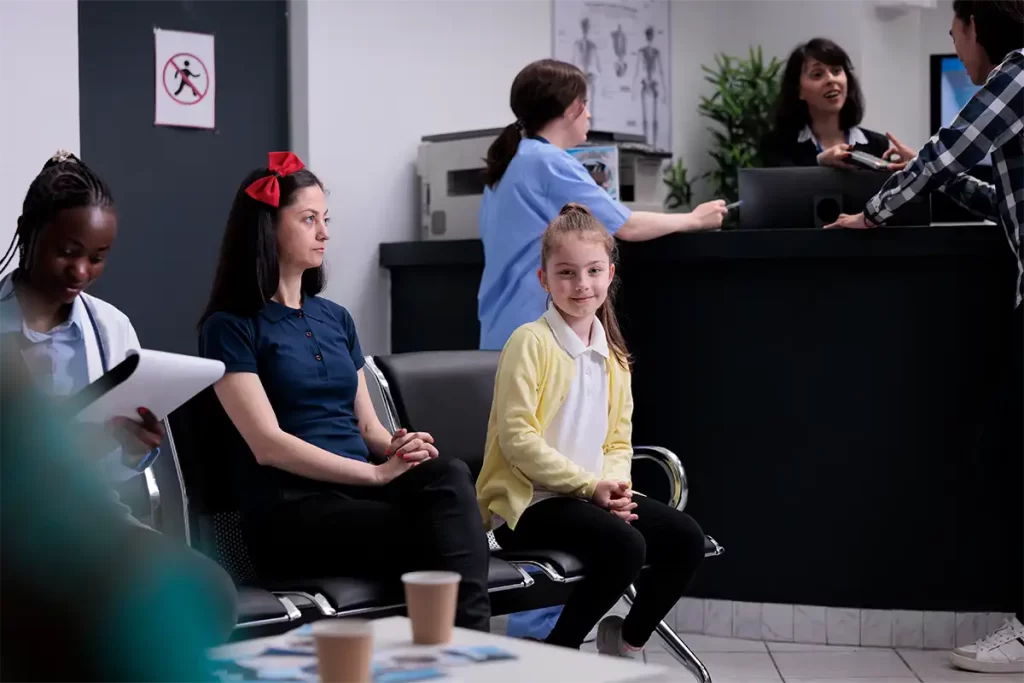Music for Waiting Rooms: Legal, Customized Playlists

No one likes to wait. In fact, experts say our brains are designed to stretch time while we’re waiting, making even a brief delay seem intolerably long. While you can’t eliminate all wait times for your customers, you could make their time pleasant through the right waiting room music.
Why Play Music in Your Waiting Room?
Waiting rooms are often the first impression that customers have of your business. Whether in a doctor’s office or a financial investment firm, the waiting room can be one of the most important spaces associated with your brand.
Interior design, including color choices, furniture placement, and the relationship of windows to your potential patrons, can make a huge difference in how your company is perceived.
The sounds in your waiting room are also important, but too few companies consider the effects of certain music or noises. For example, if your office is near a busy road, your patrons may hear loud traffic, which can disrupt the calm environment. You can set the mood and cover distracting sounds with great playlists to ease or energize your customers.
Researchers say that people waiting for serious procedures (like organ transplants or surgeries) experience higher levels of anxiety and depression that are tied to wait times. The longer they wait, the more worried they feel. That’s the same whether they’re waiting in your room or waiting at home.
Your job, researchers say, is to keep people informed of their wait times. If you’re honest about why the wait is long and why it’s required, they’re more likely to forgive you. Making the waiting space in your office is helpful too, as it could help them make good use of their time while they sit and wait for you.
Experts say waiting is easier when we’re distracted by something pleasant or potentially enjoyable. If we can enter a meditative state and let go of the fact that we’re waiting, we’re more likely to feel the time pass pleasantly. Music can make this possible.
Several studies have been performed on the impact of music in medical waiting rooms. In 2021, researchers summarized this research. Their findings include the following:
- Background music containing nature sounds decreases anxiety.
- Classical music with tempos ranging from 60 to 70 beats per minute reduced anxiety in pediatric waiting rooms.
- When given a choice, children wanted songs with words.
- Live music, performed with a guitar, resulted in greater visit satisfaction.
Studies like this demonstrate that music can be helpful in waiting rooms, but people will have somewhat different ideas about which tunes are best.
How to Choose the Right Waiting Room Music
While music might be a good option for almost any waiting room, it’s critical to find the right tunes for your environment. Following a few basic steps can make this easier.
Here’s what to do to choose the right music:
- Start with the location. How big is your space? How many speakers will you need to fill it? Will you have separate zones for music, or will everyone listen to the same thing all the time?
- Consider your services. Do you offer Eastern medicine? Do you provide a high-stress type of care (like oncology)? Do you provide legal help for stressed people? Your industry can guide you into the kind of music that seems appropriate.
- Think about your patients. Your customers will feel most comfortable with music they like. Are they older? Younger? What language do they speak?
- Dig into your brand. What are the sorts of words you use to describe your company and your services? Are you hip or traditional? Are you luxurious or value-based?
With the right words and phrases in mind, you can search for music associated with those terms. YouTube and Google can be good sources for this early research.
Once you have a potential music playlist, ask your patients and staff for feedback. Be ready to pivot based on their suggestions and ideas.
How Loud & Fast Should the Music Be?
Architects use rules from the American National Standard Criteria for Evaluating Room Noiseto help you understand how loud a room should be. Per those regulations, places like offices and private work rooms shouldn’t be louder than 40 to 45 dBA.
Free phone apps like this one allow you to measure how loud the room is. Take a measurement when the room is at the loudest (people are talking, phones are ringing, typing is happening) and ensure you’re not reaching this level.
Researchers say that music with a tempo of 60 to 72 bpm is typically described as relaxing, while songs with a tempo of 100 to 120 bpm are typically described as stimulating. If you want people to feel calm while they wait, choose slower songs. If you want them to feel energized, keep things upbeat.
Music & Patient Privacy
Music isn’t just pleasant in a healthcare setting. It can also be an important compliance feature.
The Health Insurance Portability and Accountability Act (HIPAA) requires healthcare providers to keep private information about patients protected and confidential. That means they must avoid using a patient’s full name in public spaces, and they must speak quietly when talking to family members in a waiting room.
Music can’t fully protect you from HIPAA violations. If it’s too loud, your doctors might need to yell to be heard over the tunes—undoing all of your hard work. However, soft music could help to make it harder for people to eavesdrop on sensitive medical conversations
Music or Playlists for the Waiting Room
When you use a business-focused music streaming service like PCC, you have the power to make unique playlists so you can set the literal tone for your waiting room. If you know a general mood you want your customers to experience but are unsure what songs might fit that mood (or your tastes do not suit that mood), you can always use one of the pre-designed playlists.
A study on music in medical practice waiting rooms found that some music could improve the mood of patients and staff members, but this depended on the type of music and volume. General music was not associated with improvement in anxiety or other health factors, but songs played at a lower volume were rated favorably. Classical music was ranked the highest.
Not every business benefits from classical music, but this study does suggest that background music, rather than foreground music, can help some people feel more relaxed and happier while they wait. Music without lyrics or with neutral lyrics can also improve the mood of those in your waiting room.
Many new genres of music, including ambient or instrumental, have music without lyrics. These are some examples of great waiting room music:
- Slow jazz
- Ambient electronica
- Instrumental acoustic guitar
- Instrumental covers of popular songs

CloudMusic’s Waiting Room Music
Know that you can’t just plug in your phone and fill your space with sound. You must choose a partner to help you share songs legally. CloudMusic can help.
Whether you have one location or hundreds, CloudMusic can help you find and share the right waiting room music with your customers.
Choose from more than 200 stations preprogrammed with music. Stick with a genre like smooth jazz, or blend two stations for a mix just right for your brand. We offer 99.99% uptime, so the songs keep playing no matter what.
Create dayparting schedules, so the songs change based on time of day or customer density. Grant local permissions and enable your staff to change the sound, or keep tight control over multiple locations through any connected device.
All music you’ll find on CloudMusic is licensed for commercial use. You won’t have to worry about negotiating contracts with major copyright holders, as we’ll do the work for you.

Partner with Waiting Room Experts
When you need music to set the ambiance for your business, consider using a music streaming service that understands how to legally license music for businesses, so you do not have to navigate multiple contracts with copyright holders. CloudMusic offers access to a catalog of thousands of songs and curated playlists for any business need.
Like personal music streaming services, you can use CloudMusic to find songs you love and create playlists without interrupting ads — all with one predictable, affordable monthly fee. Contact us to get started.
Sign up and start listening today
Get our most exclusive features with a no-obligation 14-day trial.
References
Our Brains Hate Waiting So We Sped Up Everything Else. (March 2015). Smithsonian Magazine.
The Psychological Burden of Waiting for Procedures and Patient-Centered Strategies That Could Support the Mental Health of Wait-Listed Patients and Caregivers During the COVID-19 Pandemic: A Scoping Review. (March 2021). Health Expectations.
The Psychology of the Wait Time Experience: What Clinics Can Do to Manage the Waiting Experience for Patients: A Longitudinal, Qualitative Study. (July 2019). BMC Health Services Research.
Speaking of Psychology: Waiting, Worrying, and Dealing with Uncertainty. (July 2023). American Psychological Association.
Music in Waiting Rooms: A Literature Review. (December 2021). Sage Journals.
Architectural Acoustics: Acceptable Room Sound Levels. Arch Toolbox.
Incidental Uses and Disclosures. (December 2002). U.S. Department of Health and Human Services.
